|
"An army of inflatable, spherical robots might one day roll around on the Martian surface," New Scientist reports. These "rolling spherical rovers" could prove key in mapping other planets – and they might even be put to work spelunking deep caves here on earth. Or, say, exploring large architectural structures: unmanned drones bouncing down the steps of Angkor Wat.
In what sounds like a fairy tale written by Freud, a woman in Japan was arrested last week for living inside another man's flat – without his knowledge or consent. The Woman Inside. The man noticed food had gone missing from his refrigerator, and so he set up a home surveillance network... which revealed the woman coming and going from a small "cubby hole" in the floor of his closet. She had apparently been living there for nearly a year. BBC. (Thanks, Alex!)
Buildings and books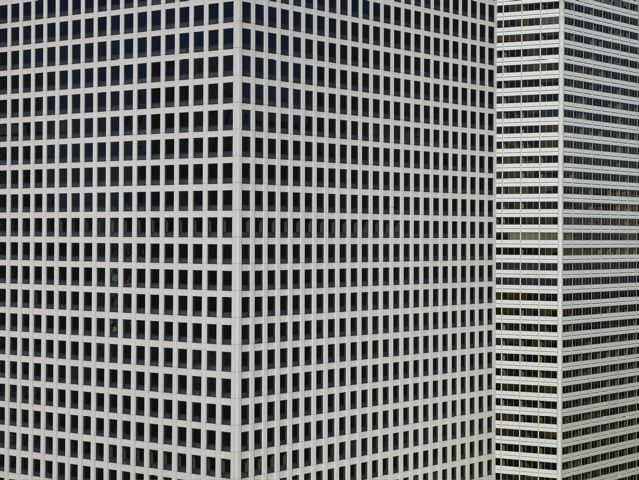 [Image: From The Transparent City by Michael Wolf; browse through the project on Wolf's website]. [Image: From The Transparent City by Michael Wolf; browse through the project on Wolf's website].I've got some essays coming out this year in books that might be of interest to BLDGBLOG readers; so while the blog has been a little slow over the past few months, I've been working like crazy on other projects. In any case, one of those books has already been published, and the others will be available in the next few months. The already published book is What is a City? Rethinking the Urban After Hurricane Katrina, edited by Rob Shields and Phil Steinberg. 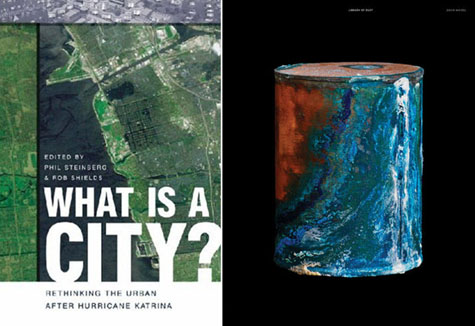 For that book, published by the University of Georgia Press, my wife and I co-wrote a chapter about New Orleans and urban flood control, citing John McPhee, China Miéville, the floating houses of Dura Vermeer, the "engineered deterrestrialization" of the lower Mississippi through the implantation of genetically modified artificial marshlands, and maybe a hundred other things, including a short history of the Army Corps of Engineers. For that book, published by the University of Georgia Press, my wife and I co-wrote a chapter about New Orleans and urban flood control, citing John McPhee, China Miéville, the floating houses of Dura Vermeer, the "engineered deterrestrialization" of the lower Mississippi through the implantation of genetically modified artificial marshlands, and maybe a hundred other things, including a short history of the Army Corps of Engineers. It was an extremely fun chapter to write, and it appears alongside some great papers; those run the gamut from geography and public policy to community activism and philosophy – and it would look great in your own university library... A book forthcoming this Fall, meanwhile, is Library of Dust by David Maisel. 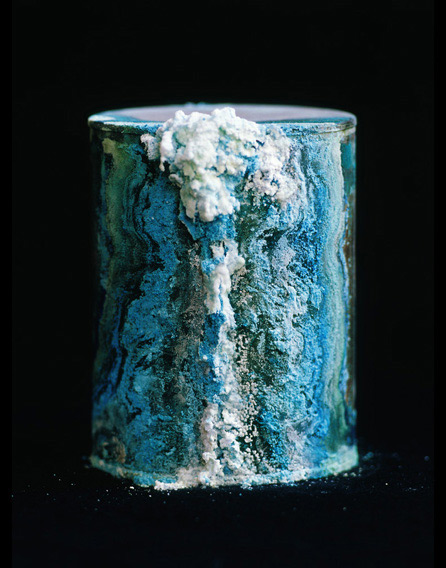 [Image: From Library of Dust by David Maisel; read about the project on Maisel's website]. [Image: From Library of Dust by David Maisel; read about the project on Maisel's website].If you haven't read the long interview I did with David a few years ago for Archinect, then I would urge you to check it out. For that book, published by Chronicle, I used a few scenes from Haruki Murakami's novel Hard-Boiled Wonderland and the End of the World to discuss the universal presence of dust and what Walter Benjamin might call the auratic nature of historical artifacts (the essay does not use the word "auratic," you'll be happy to hear). Maisel's book also has essays by Terry Toedtemeier, curator of photography for the Portland Art Museum, and Michael Roth. Maisel's own description of the work is fantastic:
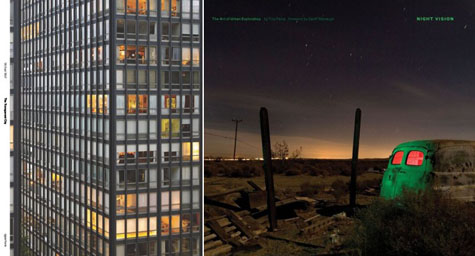 Coming out even sooner is Night Vision: The Art of Urban Exploration by Troy Paiva; that's also published by Chronicle. For that book I wrote an introduction, citing W.G. Sebald, the Romanticism of desert ruins, and the strange visual appeal of catastrophe. Coming out even sooner is Night Vision: The Art of Urban Exploration by Troy Paiva; that's also published by Chronicle. For that book I wrote an introduction, citing W.G. Sebald, the Romanticism of desert ruins, and the strange visual appeal of catastrophe. Troy's Flickr page is a must-see as you wait for the book to be delivered; there's even a special set for Night Vision (and many others). Don't miss High Desert Nights. Troy's first book was Lost America: The Abandoned Roadside West. 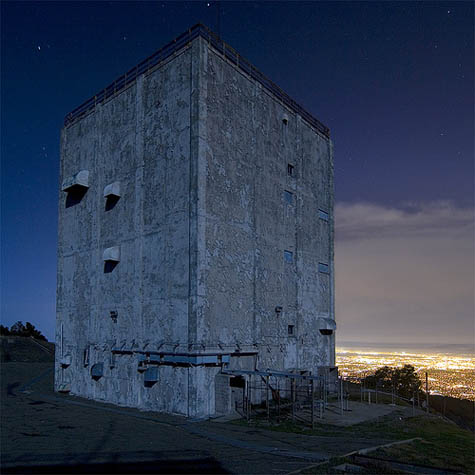  [Images: The Cube and Lenticular by Troy Paiva, from his forthcoming book Night Vision]. [Images: The Cube and Lenticular by Troy Paiva, from his forthcoming book Night Vision].And, last but not least, there's The Transparent City by Michael Wolf, which also contains an essay by Natasha Egan. Wolf is an amazing photographer; his Architecture of Density series is now legendary, and his many other projects are worth several hours – whole days – of your time. Glimpses of The Transparent City, shot entirely in Chicago, can be found on Wolf's website. My essay in that book draws heavily on J.G. Ballard's novel High-Rise, exploring the psychology of large architectural structures. Harvard's Project on the City also makes a brief appearance. You can read an excerpt from it here. 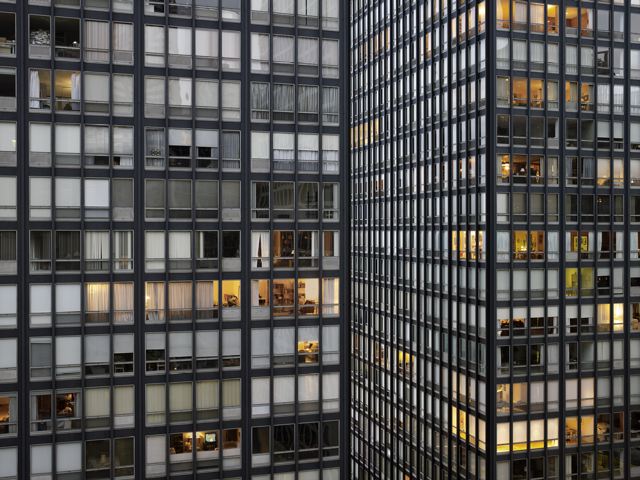 [Image: The Lake Shore Drive Apartments by Mies van der Rohe, photographed by Michael Wolf, from The Transparent City]. [Image: The Lake Shore Drive Apartments by Mies van der Rohe, photographed by Michael Wolf, from The Transparent City].So check those books out if you get the chance! Amazon Links: — What is a City? Rethinking the Urban After Hurricane Katrina edited by Rob Shields and Phil Steinberg — Library of Dust by David Maisel — Night Vision: The Art of Urban Exploration by Troy Paiva — The Transparent City by Michael Wolf Olympic Choreography The visually underwhelming London Olympics stadium, designed by HOK Sport, might actually be broken down into its constituent parts once the 2012 Summer Games are over and shipped off to Chicago – where it will be partially reassembled. The visually underwhelming London Olympics stadium, designed by HOK Sport, might actually be broken down into its constituent parts once the 2012 Summer Games are over and shipped off to Chicago – where it will be partially reassembled.Perhaps this act will open the door to a new choreography of reused, plug-and-play architectural structures, with fragments of existing buildings being FedEx'd around the world to fit one into the other in a delirium of improvised building space. Cathedral pods and office modules meet in a haze of stadium seating and hobby lobbies on the outskirts of San Francisco. New rooms are trucked in from somewhere east of Reno. You buy part of the London stadium for yourself and build a treehouse with it. Of course, does this also imply that there could be architectural stowaways? Crossing borders and exploring the complex fringes of territorial sovereignty by hiding out within pieces of mobile architecture – riding conference halls and classrooms throughout the circuits of global commerce... before stepping out, like a scene from an Alfred Hitchcock film, onto the tropical streets of Manila. You then jump into a nearby taxi and disappear. The taxi is then shipped to New York. Where surrealism meets the postal service. Or perhaps surrealism is a kind of postal service, with objects popping up where they are not supposed to be. The Other Night Sky
Every once and a while there's a flash in the sky, lasting roughly twenty seconds, and – provided you look into these things in advance – you can accurately predict when the flash is coming. It's thus possible to be there when it happens.
You can point up at the sky for amazed friends, saying watch this – and a light appears, way up above you, beyond even where airplanes fly.  What's passing overhead in this instance is something called the Iridium constellation, an artificial pattern made of 66 telecom satellites (there were supposed to be 77, which would have corresponded with the number of electrons in an atom of iridium).
What's passing overhead in this instance is something called the Iridium constellation, an artificial pattern made of 66 telecom satellites (there were supposed to be 77, which would have corresponded with the number of electrons in an atom of iridium). The whole thing was sold less than a decade ago for a mere $25 million to private investors – after being launched and constructed, in the 1980s, at a price of nearly $6 billion. 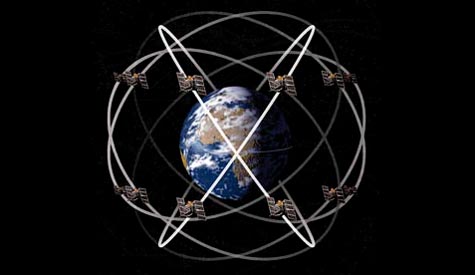 The company that initially sponsored the project went bankrupt in 1999 – raising the prospect, like something from Greek mythology as rewritten by Philip K. Dick, or perhaps something out of Arthur C. Clarke as rewritten by Homer, that our sky will someday be full of artificial constellations, their human creators having long since disappeared. Cold, dead objects, they'll encircle the world in silence.
The company that initially sponsored the project went bankrupt in 1999 – raising the prospect, like something from Greek mythology as rewritten by Philip K. Dick, or perhaps something out of Arthur C. Clarke as rewritten by Homer, that our sky will someday be full of artificial constellations, their human creators having long since disappeared. Cold, dead objects, they'll encircle the world in silence.  Along these lines, a new exhibition of photographs by geographer Trevor Paglen opens here in the Bay Area next week, called The Other Night Sky. The Other Night Sky "looks to the night sky as a place of covert activity," we read:
Along these lines, a new exhibition of photographs by geographer Trevor Paglen opens here in the Bay Area next week, called The Other Night Sky. The Other Night Sky "looks to the night sky as a place of covert activity," we read:[W]orking with data compiled by amateur astronomers and hobbyist “satellite observers,” cross-referenced across many sources of information, [Paglen] tracks and presents what he calls “the other night sky.” Large-scale astro-photographs isolate barely perceptible traces of surveillance vessels amidst familiar star fields, and a digitally animated projection installation covers the globe with 189 currently orbiting satellites.In other words, Paglen has been tracking surveillance satellites – false stars that would otherwise have blended in with astronomy. It genuinely amazes me to think that, 45,000 years ago, groups of cognitively modern humans were wandering around Australia and the Middle East and Africa and South Asia, and they were looking up at and navigating themselves by recognizable patterns in the sky – but, now, we can just install our own stars there and guide ourselves by them, instead. 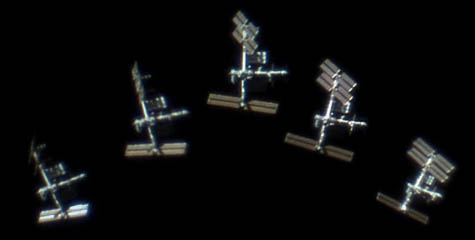 [Image: The International Space Station, from a series of photos by Dirk Ewers]. [Image: The International Space Station, from a series of photos by Dirk Ewers].We are now partially building ourselves a new night sky – yet this surrogate astronomy is being put there simply so we can spy each other and make international phone calls.  In some ways, I'm reminded of a line from Richard Kenney's 1993 book of poetry The Invention of the Zero. At one point, Kenney writes: "Imagine, all new constellations!" as if it is some impossible, heroic act of celestial reinvention yet to occur in human history.
In some ways, I'm reminded of a line from Richard Kenney's 1993 book of poetry The Invention of the Zero. At one point, Kenney writes: "Imagine, all new constellations!" as if it is some impossible, heroic act of celestial reinvention yet to occur in human history.But the weird irony of life is that we've already done that – and we didn't overthrow the astronomers, or plan a coup in the planetarium of human thought, we just launched some telecom satellites and bought a bunch of mobile phones, and now we have it: we have new constellations – what Kenney calls "unfamiliar skies" – flashing through the night at timed intervals. 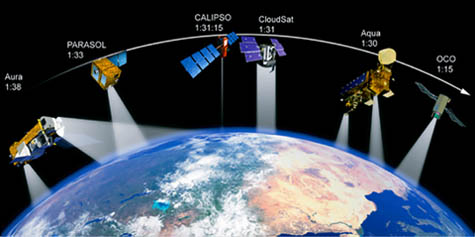 In any case, I've been tracking these constellations on a little Applet today – but there's a certain sinister side to all of this, too. Space warfare, we read, is the militarization of the earth's high atmosphere, weaponizing low-orbit space. You can thus strike anyplace on the earth within mere minutes of ordering an attack – including the infamous "rods from god," which are non-explosive tungsten rods dropped from extremely high altitude:
In any case, I've been tracking these constellations on a little Applet today – but there's a certain sinister side to all of this, too. Space warfare, we read, is the militarization of the earth's high atmosphere, weaponizing low-orbit space. You can thus strike anyplace on the earth within mere minutes of ordering an attack – including the infamous "rods from god," which are non-explosive tungsten rods dropped from extremely high altitude: These rods, which could be dropped on a target with as little as 15 minutes notice, would enter the Earth's atmosphere at a speed of 36,000 feet per second – about as fast as a meteor. Upon impact, the rod would be capable of producing all the effects of an earth-penetrating nuclear weapon, without any of the radioactive fallout. This type of weapon relies on kinetic energy, rather than high-explosives, to generate destructive force.All these coordinated astronomical stand-ins – patterned groups of satellites moving around the world – thus might also someday serve as malign horoscopes of impending war. To what zodiac would such military constellations correspond? What defensive measures might a person take when a strange metallic glint appears in the evening sky, a 20-second flash on the horizon?  [Image: The Perseus Cluster, photographed by Jean-Charles Cuillandre & Giovanni Anselmi]. [Image: The Perseus Cluster, photographed by Jean-Charles Cuillandre & Giovanni Anselmi].And what would we do if we found out that Orion, say, or the Southern Cross, was not a natural constellation at all, but something placed there, installed above us, in our imaginations, in our myths? (Trevor Paglen's The Other Night Sky, from which this post's title was taken, opens June 1st at the Berkeley Art Museum). Caverns in light [Images: An exploding star's "light echo," as captured by the Hubble Space Telescope back in 2002. View larger!]. [Images: An exploding star's "light echo," as captured by the Hubble Space Telescope back in 2002. View larger!]."In January 2002," NASA reported half a decade ago, "a dull star in an obscure constellation suddenly became 600,000 times more luminous than our Sun." This "mysterious star" produced, in the process, a "light echo" that "uncovered remarkable new features" in that star's astral architecture. "These details promise to provide astronomers with a CAT-scan-like probe of the three-dimensional structure of shells of dust surrounding an aging star." In the above sequence of images, then, you are looking at "continuously changing cross-sections of the dust envelope" – a visual effect compared by NASA to "a spelunker taking a flash picture of the walls of an undiscovered cavern," where the "cavern" in question is an exploding sphere of light. A spectacular geology, indeed. Imagine if the most beautiful thing in the universe only exists for a billionth of a second. Imagine if no one sees it. Radio Reservations [Image: Photo by Dave Bullock for Wired; these images are only visually related to this post]. [Image: Photo by Dave Bullock for Wired; these images are only visually related to this post].Flipping through back issues of New Scientist, in a late spring cleaning of the BLDGBLOG office, I came across two plans for radio astronomy parks that I thought worth mentioning here. On the one hand, there's the Square Kilometer Array (SKA). The Array, which will consist of "thousands of antennas with a total collecting area of 1 square kilometre," requires a "radio-quiet reserve." That is, it can only function properly given "little or no interference from radio signals of human origin." There are two sites now in competition to host it: South Africa's northern Karoo region and someplace in the Australian outback. The South African site refers to itself as a Radio Astronomy Reserve; the Reserve, if protected by South Africa's so-called Astronomy Geographic Advantage Act, could include as much as 12 million hectares of landed radio silence (close to 31 million acres).  [Image: Photo by Dave Bullock for Wired]. [Image: Photo by Dave Bullock for Wired].On the other hand, there are plans for a radio astronomy reserve that would not even be with us here on Earth: Paris-based radio astronomer Claudio Maccone "is calling on the United Nations to recognise a 1820-kilometre-diameter zone on the moon's far side as the 'Protected Antipode Circle'. A crater called Daedalus within this area would be suitable for a future radio-astronomy base," Maccone suggests – implying that "the moon's far side will one day be a haven for radio telescopes, free from the electronic chatter of Earth and the many satellites now orbiting it." Briefly, I wonder if this future lunar radio base should be open to an architectural design competition. And what of the site in South Africa – could we invent some sort of new architectural typology here: the radio astronomer's hut, complete with sleeping quarters, skylights, and stacks of back-up harddrives? Both terrestrial and otherwise, these "optimal radio environments," as New Scientist describes them, would exist within interesting overlaps of land use policies, preservation statutes, and massively coordinated techno-financial investment networks – complete with quite sizable maintenance and security bills. How strange it would be, then, to be an armed guard standing there alone at night in the darkness with your back to a machine, its towering dish pointed upward, a mere silhouette in the sky, tracking galaxial magnetism and the slow evolution of stars – till the quiet whir of recalibration tilts that hulking mass a fraction of a degree back down toward the horizon. It's the only sound you hear for the next two hours. The radio astronomy reserve as a new site for experimental forms of human solitude. Inside the Test Village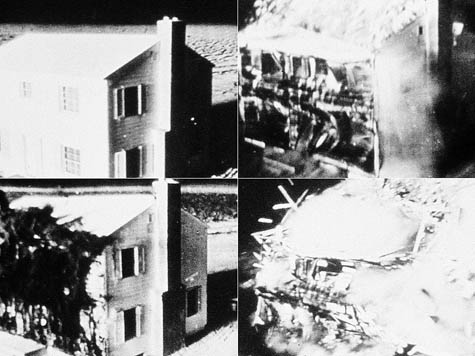 I saw Indiana Jones and the Kingdom of the Crystal Skull last night – a film I'll resist reviewing here, despite the temptation – but there is at least one scene that I want to point out. I won't give away any real plot details, but you might not want to read this post if you plan on seeing the movie. I saw Indiana Jones and the Kingdom of the Crystal Skull last night – a film I'll resist reviewing here, despite the temptation – but there is at least one scene that I want to point out. I won't give away any real plot details, but you might not want to read this post if you plan on seeing the movie. So, quite early in the film, Indiana Jones escapes from a U.S. military warehouse at night on a remote base in Nevada, where he's been taken by alien-obsessed Russian captors. After the sun comes up the next morning, he finds himself climbing over a fence into a cul-de-sac of detached houses. It's a suburb in the middle of nowhere, impeccably maintained. He knocks on one of the doors, hears nothing, and so goes inside, calling for help. A TV is blaring in the other room – but when Indiana Jones walks through to the front of the house, he finds that the house is full of mannequins. There are mannequins watching TV – fake, plastic people with their eyes fixed to the screen. So he goes out onto the street – and the street, too, is lined with mannequins, little brown-haired kids on bikes and men outside in driveways as if to wash their family cars. And then a distant, amplified voice booms out over the roar of an air raid siren: the weapons test will begin in ten... nine... eight... Because he's just walked into an atomic bomb testing village – and now he has to find someplace to hide. Deep-water city-states [Image: Illustration by Holl Liou, courtesy of Wired]. [Image: Illustration by Holl Liou, courtesy of Wired].Wired reports on "a small team of Silicon Valley millionaires" who hope to develop "a new option for global citizenship: A permanent, quasi-sovereign nation floating in international waters." They call this practice seasteading.
The group's 300-page book on the managerial practicalities of running "modular seastead groups" references everything from Sealand, the offshore micronation, to the Texas Tower, to houseboats, to the dangers of tropical storms.  [Images: The Maunsell Towers (top), unmentioned by the libertarian seasteaders, and the Texas Tower (bottom)]. [Images: The Maunsell Towers (top), unmentioned by the libertarian seasteaders, and the Texas Tower (bottom)].They touch on the political and economic circumstances involved in steading the high seas, including SOLAS, the International Convention for the Safety of Life at Sea, and UNLOS, the United Nations Law of the Sea. They mention the process of buying a Flag of Convenience, in which hopeful microsovereigns can "shop around for a country that has the least objectionable laws and rates, and count on the seller’s apathy to minimize restrictions. A seastead is potentially high-profile, and if it proves a serious embarrassment to a registrar it may lose its flag." The seastead's power storage needs are then discussed in terms of electrochemical batteries, gravity batteries, and supercapacitors, and the production of this power will, the authors presume, come from wind and solar systems, and even one or two fuel-powered generators. Of course, there's also the power of the sea to consider – and the authors' "favorite" method for harvesting "wave power" is something called Isaac's Wave Pump.  [Image: Tapping into oceanic motion with BioPower Systems]. [Image: Tapping into oceanic motion with BioPower Systems].In any case, one can fantasize forever about endless small changes in the construction of a functioning seastead. (Note to Chronicle Books: publish an architectural guide to seasteading; it'll be a huge hit on Father's Day). What interests me here, aside from the architectural challenge of erecting a durable, ocean-going metropolis, is the fact that this act of construction – this act of building something – has constitutional implications. That is, architecture here proactively expands the political bounds of recognized sovereignty; architecture becomes declarative. The stakes for design have gone up, in other words. It's not just a question of producing better loft apartments, for which you can charge an extra $300,000, or of perfecting the art of luxury kitchen space; it's a question of designing architecture for extreme conditions and, should your architecture survive, thus opening up room for a new form of what might be called post-terrestrial sovereignty, i.e. governance freed from landed terrain. Which is not to be confused with advocacy of the project; I just like discussing its political side-effects: architecture becomes wed with, indeed inseparable from, a political project. It is construction in the service of constitutionality (and vice versa). Wed with oceanic mobility, the architecture of seasteading doesn't just aesthetically augment a natural landscape; it actually encases, or gives physical shape to, a political community. It is architecture as political space in the most literal sense. The Digital Replacement of the Natives [Images: Garmin GPS devices]. [Images: Garmin GPS devices]."For their recent trip to Namibia," a short blurb in Wired magazine explains, "Greg and Anja Manuel packed light: PowerBars, clothes, and a Garmin GPS loaded with Traveler's Africa version 8.02, a user-generated map brimming with 50,000 points of interest. That last item meant they didn't have to hire an experienced guide." Fair enough. The map looks beautiful, the idea is cool, and, within two or three trips, the GPS device does indeed save money; however, I can't help but wonder what this might foretell for local economies, all over the world, based on guided tourism. For instance, a small group of American tourists comes through your village, eating PowerBars and looking at handheld GPS devices. They don't go to any restaurants; they don't ask any questions of anyone; perhaps they don't even rent a hotel room. For all economic purposes, it's as if they were never there. They were more like surreal poltergeists wearing Vasque boots, reading Jonathan Safran Foer on a Kindle. What better way to avoid meeting Namibians! Just use their electrical grid to recharge your gadgets, pay no taxes, and leave. 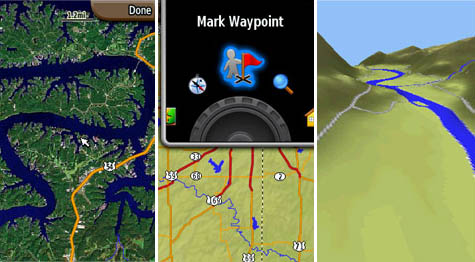 [Images: Three examples of maps displayed on Garmin GPS devices]. [Images: Three examples of maps displayed on Garmin GPS devices].I'm left imagining the inverse of this situation, of course, in which a small group of Namibians shows up in London. They ask no questions, eat at no restaurants, and avoid all hotels – before going off to wander round the countryside, sleeping in tents. It would all seem rather mysterious. In any case, do handheld technologies mean that we'll soon be digitally replacing the native populations of the Third World, never needing them again for guidance, travel advice, or even insights into medicinal plantlife? You fly down to the Amazon to try ayahuasca, but you don't hire any local shamans or native botanists because you've got everything you need to know already saved on a 300GB iPod – as if that might be the atomized fate of the West in general: desperately seeking visions, alone in the wild, surrounded by portable gadgetry. "Your tradition is right here," the tourist says, holding his Garmin GPS loaded with Traveler's Africa version 8.02 over the heads of impoverished villagers. "I don't need you anymore." Next year, someone gives you a small handheld device with an interestingly honest tagline. Go Everywhere, it says. Meet No One. Mountain Monuments [Image: From the series the water, the dams, the landscape by photographer Eduoard Decam]. [Image: From the series the water, the dams, the landscape by photographer Eduoard Decam].Eduoard Decam is a Barcelona-based French architect whose photographic project the water, the dams, the landscape won an EDF Foundation award back in 2006. The images in the series document massive hydrological installations in the Pyrenees Mountains of northeastern Spain, turning dams and spillways into abstract monuments, like some new piece of mountain infrastructure designed by Superstudio. As Decam himself explained to A10 magazine: "I do not see the dam as a technical element in the mountain, but as part of the mountain, as a landscape." Personally, I'm just blown away by the terraced stairways we see in the image, above; it's like some ultramodern update to the monastic retreats of Meteora, or perhaps even a new stage in Guild Wars. (Spotted in A10, issue #19). Botanical Otology
Alex Metcalf's Tree Listening Installation is a small electronic listening device built for eavesdropping on the inner acoustics of trees.
 [Image: "Peach Tree in Flower in Orchard" by J.E. Fee]. [Image: "Peach Tree in Flower in Orchard" by J.E. Fee].How does it work? The device is placed on the trunk of a given tree and then connected to as many as ten sets of headphones, which hang down from the tree's canopy. Botany becomes your iPod. "This allows the public to listen 'live' to the sound of water being pulled up from the roots to the leaves through the xylem tube," Metcalf writes. As he explained in an interview with the Guardian last week: "The technology for this is usually invasive. You bore into the tree and take away a section, then seal in a listening device. The thing about my device is that you don't have to cause any damage, and you can listen to any tree, anywhere, any time – plus you can do it long term. Cutting a hole in a tree means you are wounding and infecting it, which will affect the recording." The "device" in question is a small and somewhat unassuming metal cone that looks more like an 18th-century otological device. You hold it up against the side of the tree – like an FBI roving wiretap on the natural world – and listen in... But could you broadcast this? A pirate radio station pops up one evening after dinner time in the distant suburbs of west London – and it turns out that an eccentric old couple living on a large plot of land near Windsor Great Park have begun broadcasting their trees. It's soon an international sensation, and a great hit with cover bands; you go down to the Cafe du Nord one night to hear live music, but the band, visibly drunk, gets lost in a three-hour rendition, using only acoustic guitars, of the sound of young sessile oak trees. Oddly, you're the only one there who enjoys it – legs crossed, beer in hand, listening intently. Deep in the basement of an ancient tenement on Second Avenue in the heart of midtown New York City, I was fishing
Last summer, on the extremely short-lived blog Urbablurb – which only managed five posts before dying, yet still remains interesting today – we read about the little-known phenomenon of people fishing in the basements of Manhattan.
 [Image: A map of the lost rivers of Manhattan, via Urbablurb]. [Image: A map of the lost rivers of Manhattan, via Urbablurb].Urbablurb quotes from The New York Times:
With plum-bob and line, I cast in and found the stream to be over six feet deep. The spray splashed upwards from time to time and standing on the basement floor, I felt its tingling coolness. One day I was curious enough to try my hand at fishing. I had an old-fashioned dropline and baited a hook with a piece of sperm-candle. I jiggled the hook for about five minutes and then felt a teasing nibble. Deep in the basement of an ancient tenement on Second Avenue in the heart of midtown New York City, I was fishing. Alas, we also learn that, as to the question of "whether any carp could be found swimming under Manhattan today," the answer, sadly, is no. But how much would I love to find myself in New York City for a weekend, perhaps sent there by work to cover a story – when the phone rings in my hotel room. It's 11pm. I'm tired, but I answer. An old man is on the other end, and he clears his throat and he says: "I think this is something you'd like to see." I doubt, I delay, I debate with myself – but I soon take a cab, and, as the clock strikes 12am, I'm led down into the basement of a red brick tenement building on E. 13th Street. I step into a large room, that smells vaguely of water – and six men are sitting around an opening in the floor, holding fishing poles in the darkness. (Also on Urbablurb: Who is Jack Gasnick?). Vertical House [Image: Vertical House by axis mundi architects]. [Image: Vertical House by axis mundi architects].Here are two views of a proposed mountain house for a site in Smugglers Notch, Vermont, by New York architects axis mundi. "Entry is via a long and dramatic bridge to a viewing platform from which one ascends a staircase into the house," the architects' website explains. Kitchen, dining room, living room, and master bedroom are encountered in sequence as one moves upward through the structure. 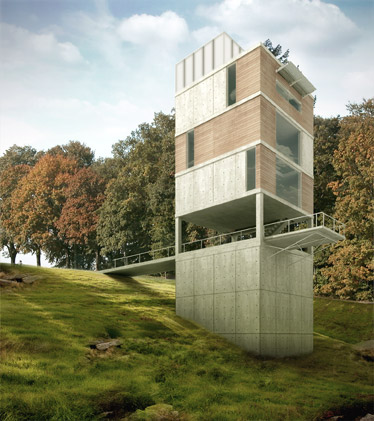 [Image: Vertical House by axis mundi architects]. [Image: Vertical House by axis mundi architects].You eventually arrive at an "open air garden... situated on the roof."
Give that thing wider corner posts, run the utilities and services down through through them, and you're good to go. Install a portaledge or two, and the house gets even better. Then, three hundred years from now, refugees from a half-flooded Manhattan – that city all but destroyed by an unspecified disaster – make their way north to find the house still standing and covered in a thick labyrinth of vines, home to migrating tropical birds. They clear themselves a place to sleep amidst the dust and vines, and stay for nearly two weeks – before heading further inland, toward the ruins of Montreal, still fleeing whatever unknown fate awaits those stuck in that city down south. Another hundred years and the building collapses, forming a debris field of wood, metal, and concrete across the hillside, washing down to nothing over decades of rain.
|




